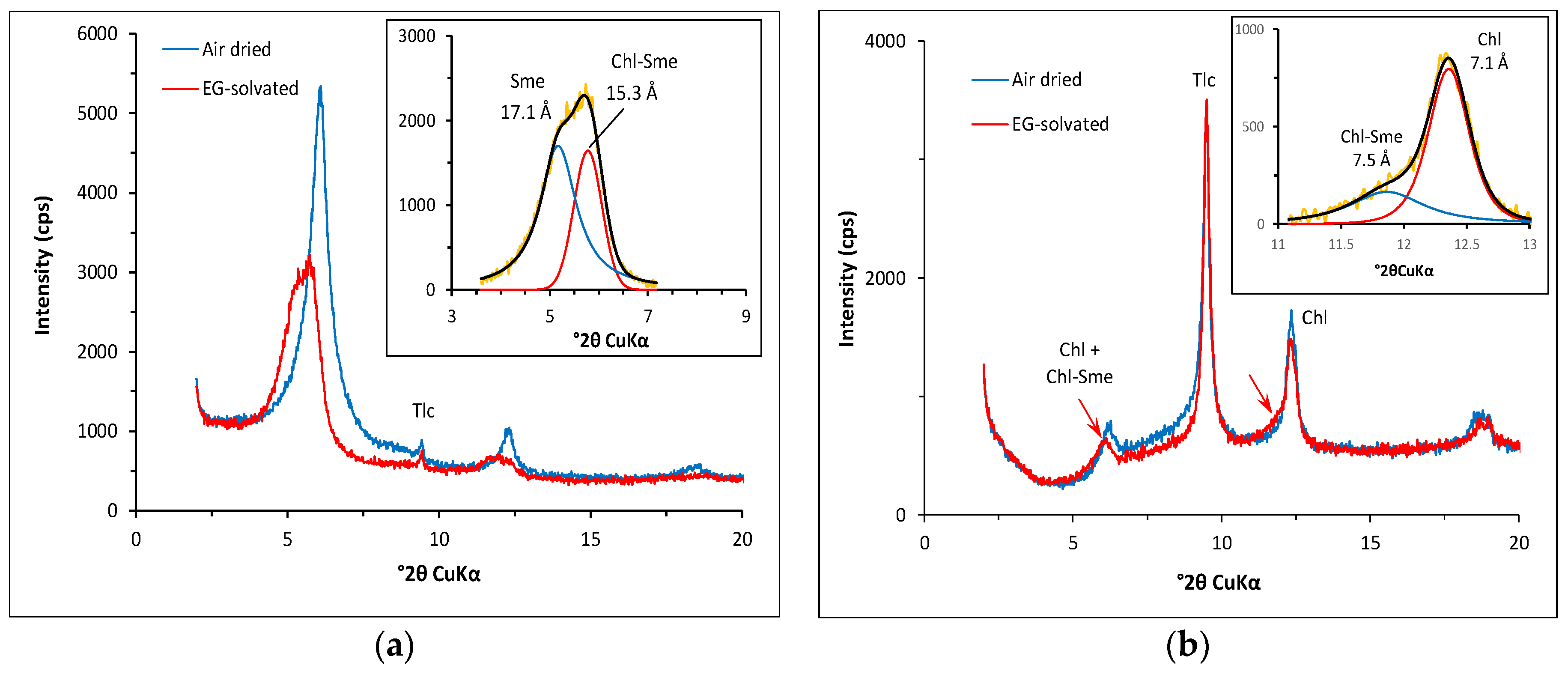Diagenesis of the Sedimentary Fe–Ni Deposits of Euboea: Evidence Based on Phyllosilicate Mineralogy †
Abstract
:1. Introduction
2. Materials and Methods
3. Results
3.1. Mineral Textures and Bulk Mineralogy of the Fe–Ni Ores
3.2. Clay Mineralogy
4. Discussion
5. Conclusions
Author Contributions
Funding
Institutional Review Board Statement
Informed Consent Statement
Acknowledgments
Conflicts of Interest
References
- Valeton, I.; Biermann, M.; Reche, R.; Rozenberg, F. Genesis of nickel laterites and bauxites in Greece during the Jurassic and the Cretaceous and their relation to ultrabasic rocks. Ore Geol. Rev. 1987, 2, 359–404. [Google Scholar] [CrossRef]
- Rosenberg, F. Geochemie und Mineralogie Lateritischer Nickel und Eisenerze in Lokris und auf Euboa, Griechenland, Unpublished. Ph.D. Thesis, University of Hamburg, Hamburg, Germany, 1984. (In German). [Google Scholar]
- Andoniades, P.A.; Vgenopoulos, A. Study of the nickeliferous bauxitic laterite of the area N. Kokkino-Lokris. Metal. Miner. Ann. 1989, 65, 51–60. [Google Scholar]
- Mposkos, E.; Perraki, T.; Kolokotroni, K. The Ni and Cr distribution in the mineralogical phases of the nickeliferous laterites from Evia Island. Miner. Wealth 1996, 101, 9–26. (In Greek) [Google Scholar]
- Mposkos, E.; Orphanoudaki, A.; Perraki, T. The Ni distribution in the mineral phases of Greek Fe-Ni laterite deposits. In Proceedings of the 3rd Congress of Mineral Wealth, Athens, Greece, 22–24 November 2000; pp. 107–115. [Google Scholar]
- Samouchos, M.; Godelitsas, A.; Nomikou, C.; Taxiarchou, M.; Tsakiridis, P.; Zavasnik, J.; Gamaletsos, P.; Apostolikas, A. New insights into nanomineralogy and geochemistry of Ni-laterite ores from central Greece. Chem. Erde 2018, 79, 268–279. [Google Scholar] [CrossRef]
- Christidis, G.E.; Skarpelis, N. Clay mineralogy of the sedimentary iron nickel ore of Agios Ioannis, NE Boeotia: New data and implication for diagenetic modifications. Bull. Geol. Soc. Greece 2010, 43, 2553–2561. [Google Scholar] [CrossRef] [Green Version]
- Eliopoulos, D.; Economou-Eliopoulos, M.; Apostolikas, A.; Golightly, J.P. Geochemical features of nickel-laterite deposits from the Balkan Peninsula and Gördes, Turkey: The genetic and environmental significance of arsenic. Ore Geol. Rev. 2012, 48, 413–427. [Google Scholar] [CrossRef]
- Kalatha, S.; Perraki, M.; Economou-Eliopoulos, M. The origin of bastnaesite (La, Nd, Y) in the Nissi (Patitiria) bauxite-laterite deposit, Lokris, Greece. Minerals 2017, 7, 45. [Google Scholar] [CrossRef] [Green Version]
- Christidis, G.E.; Mitsis, I. A new Ni-rich stevensite from the ophiolite complex of Othrys, central Greece. Clays Clay Miner. 2006, 54, 653–666. [Google Scholar] [CrossRef]
- Mano, E.S.; Caner, L.; Petit, S.; Chaves, A.P.; Mexias, A.S. Mineralogical characterisation of Ni-bearing smectites from Niquelândia, Brazil. Clays Clay Miner. 2014, 62, 324–335. [Google Scholar] [CrossRef]
- Fonteneau, L.; Caner, L.; Petit, S.; Juillot, F.; Ploquin, F.; Fritch, E. Swelling capacity of mixed talc-like/stevensite layers in white/green clay infillings (“deweylite”/“garnierite”) from serpentine veins of faulted peridotites, New Caledonia. Am. Mineral. 2020, 105, 1536–1546. [Google Scholar] [CrossRef]
- Wojdyr, M. A general-purpose peak fitting program. J. Appl. Cryst. 2010, 43, 1126–1128. [Google Scholar] [CrossRef]
- Warr, L.N. Recommended abbreviations for the names of clay minerals and associated phases. Clay Miner. 2020, 55, 261–264. [Google Scholar] [CrossRef]
- Warr, L.N. IMA-CNMNC approved mineral names. Mineral. Mag. 2021, 85, 291–320. [Google Scholar] [CrossRef]
- Buatier, M.D.; Früh-Green, G.L.; Karpoff, A.M. Mechanisms of Mg-phyllosilicate formation in a hydrothermal system at a sedimented ridge (Middle Valley, Juan de Fuca). Contrib. Mineral. Petrol. 1995, 122, 134–151. [Google Scholar] [CrossRef]
- Beaufort, D.; Baronnet, A.; Lanson, B.; Meunier, A. Corrensite: A single phase or mixed-layer phyllosilicate in the saponite-to-chlorite conversion series? A case study of Sancerre-Couy deep drill hole (France). Am. Miner. 1999, 82, 109–124. [Google Scholar] [CrossRef]
- Robinson, D.; Schmidt, S.T.; Santana de Zamora, A. Reaction pathways and reaction progress for the smectite-to-chlorite transformation: Evidence from hydrothermally altered metabasites. J. Metamorphic Geol. 2002, 20, 167–174. [Google Scholar] [CrossRef]
- Ryan, P.C.; Hillier, S. Berthierine/chamosite, corrensite and discrete chlorite from evolved verdine and evaporate-associated facies in the Jurassic Sundance Formation, Wyoming. Am. Miner. 2002, 87, 1607–1615. [Google Scholar] [CrossRef]
- Drits, V.A.; Ivanovskaya, T.A.; Sakharov, B.A.; Zviagyna, B.; Gor’kovam, N.V.; Pokrovskaya, E.V.; Savichev, A.T. Mixed-layers corrensite-chlorites and their formation mechanisms in the glauconic sandstones-clayed rocks (Riphean, Anabar uplift). Lithol. Miner. Res. 2011, 46, 566–593. [Google Scholar] [CrossRef]
- Beaufort, D.; Rigault, C.; Billon, S.; Billault, V.; Inoue, A.; Inoue, S.; Patrier, P. Chlorite and chloritization processesthrough mixed-layer mineral series in temperature geological systems—A review. Clay Miner. 2015, 50, 497–523. [Google Scholar] [CrossRef]




Publisher’s Note: MDPI stays neutral with regard to jurisdictional claims in published maps and institutional affiliations. |
© 2021 by the authors. Licensee MDPI, Basel, Switzerland. This article is an open access article distributed under the terms and conditions of the Creative Commons Attribution (CC BY) license (https://creativecommons.org/licenses/by/4.0/).
Share and Cite
Cheliotis-Chatzidimitriou, S.; Christidis, G.E.; Marantos, I. Diagenesis of the Sedimentary Fe–Ni Deposits of Euboea: Evidence Based on Phyllosilicate Mineralogy. Mater. Proc. 2021, 5, 73. https://doi.org/10.3390/materproc2021005073
Cheliotis-Chatzidimitriou S, Christidis GE, Marantos I. Diagenesis of the Sedimentary Fe–Ni Deposits of Euboea: Evidence Based on Phyllosilicate Mineralogy. Materials Proceedings. 2021; 5(1):73. https://doi.org/10.3390/materproc2021005073
Chicago/Turabian StyleCheliotis-Chatzidimitriou, Spyros, Georgios E. Christidis, and Ioannis Marantos. 2021. "Diagenesis of the Sedimentary Fe–Ni Deposits of Euboea: Evidence Based on Phyllosilicate Mineralogy" Materials Proceedings 5, no. 1: 73. https://doi.org/10.3390/materproc2021005073





